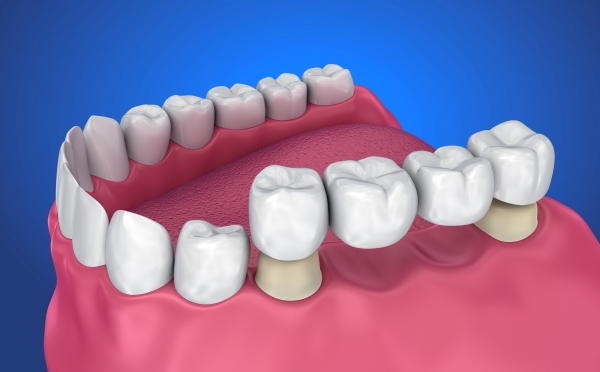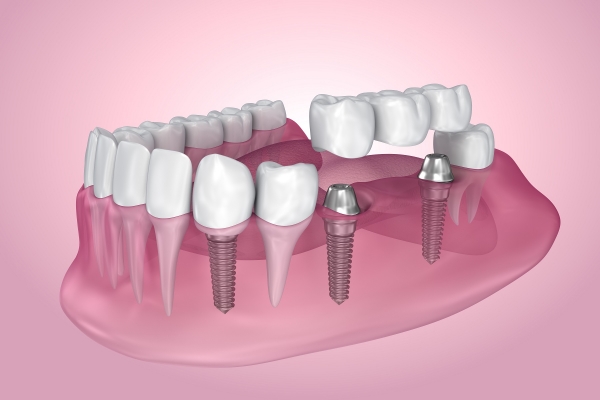 Do you have missing teeth? If so, it’s important to replace them as soon as possible. Not only will this improve the appearance of your smile, but it will also restore a fully functional bite. Failure to replace your missing teeth can lead to a wide range of oral health issues down the road. It’s much better to avoid these problems by choosing one of our tooth replacement options.
Do you have missing teeth? If so, it’s important to replace them as soon as possible. Not only will this improve the appearance of your smile, but it will also restore a fully functional bite. Failure to replace your missing teeth can lead to a wide range of oral health issues down the road. It’s much better to avoid these problems by choosing one of our tooth replacement options.
While dental implants are the most effective solution to replace missing teeth, they aren’t right for everyone. If you’re not a good dental implant candidate, dental bridges provide an excellent alternative. During your initial visit, Dr. Scott Greenhalgh will discuss your options in detail and recommend the right option for your unique needs and goals.
Contact us Today!
If have one or more missing teeth, please call 303-988-9060 to schedule an appointment and receive individualized treatment recommendations. We serve patients in Lakewood, Denver and the surrounding areas of Colorado.
Why Do I Need to Replace Missing Teeth?
Some of the problems that may develop if you fail to replace missing teeth include:
- Remaining teeth will shift to fill in the gap, causing bite alignment issues that may include TMJ
- Increased risk of gum disease
- Bone deterioration in your jaw, which may lead to additional tooth loss down the road
- Sunken facial appearance which may make you look much older than you are
- Problems chewing and eating, which can lead to malnutrition from a restricted diet
Dental bridges can help you restore a fully functional bite and help you avoid many of these problems.
Traditional Dental Bridges
 Traditional bridges consist of an artificial tooth (or two) attached to the two neighboring teeth with metal "wings." Those neighboring teeth are trimmed down to have dental crowns placed on them to support the bridge. The bridge is cemented in place and left permanently. A dental bridge can last from 5 to 20 years depending on how you care for it.
Traditional bridges consist of an artificial tooth (or two) attached to the two neighboring teeth with metal "wings." Those neighboring teeth are trimmed down to have dental crowns placed on them to support the bridge. The bridge is cemented in place and left permanently. A dental bridge can last from 5 to 20 years depending on how you care for it.
This same arrangement can also be done using all porcelain, with the artificial tooth (called a pontic) connected to its neighbors through porcelain attachments. This avoids that dark metal component in the mouth.
Cantilevered Bridges
If you think of a cantilevered balcony, you will have a general idea of how a cantilevered bridge works. The balcony is held in place by its attachment to the building and needs no support from beneath. Similarly, a cantilevered bridge is held by its connection to adjacent teeth on one side only.
Cantilevered bridges are used for:
- Back teeth when there is no tooth on the other side
- Places where the neighboring teeth are strong enough to provide sufficient support for the bridge from only one side
Maryland Bonded Bridges
A Maryland bonded bridge is a minimally invasive option that uses a composite resin cement to hold the dental bridge in place. During the procedure, small slots are trimmed into the supporting teeth. The new bridge is then bonded to the back surfaces of adjacent teeth using dental resin.
Bonded bridges are more suited to front teeth which do not need a strong chewing surface. The main advantage is that the supporting teeth need only minimal trimming.
Implant-Supported Dental Bridges
Modern dental technology allows bridges to be securely anchored with dental implants. This option gives you a permanent, safe and healthy solution to any missing teeth you might have. With implant-supported dental bridges, Dr. Greenhalgh can combine the ease and convenience of traditional bridges with the strength and durability of dental implants. This provides an outstanding, long-term tooth replacement solution.
Implant-supported dental bridges are often an excellent option when you’re missing several teeth. The process is quite similar to the traditional placement of dental implants:
- We will implant several titanium support roots in the affected area
- We wait for your body to fully integrate the support rods into your jawbone; this process, known as osseointegration, provides much of the strength and durability associated with dental implants
- Finally, we place the dental bridges on “abutments” which are attached to the support rods
 Implant-supported dental bridges offer a number of advantages over traditional bridges, including:
Implant-supported dental bridges offer a number of advantages over traditional bridges, including:
- There is no need to shave down remaining natural teeth
- Increased strength and durability
- More accurately simulates the look and feel of natural teeth
- Places no additional stress on remaining teeth
- Reverses the onset of decay in the jawbone
How Long Does it Take to Get Used to My Dental Bridge?
Your dental bridge treatment process can take some time. First, it takes time to fabricate your bridge. After preparing your teeth as needed, you'll wear a temporary restoration for a couple of weeks. Once your bridge is bonded to your natural teeth, you might experience a brief adjustment period during which your mouth adjusts to the contours of your new teeth. During this time, which can last about two weeks, you may feel some soreness or sensitivity. You can manage these minor side effects by using toothpaste for sensitive teeth and by limiting your consumption of foods and beverages that are very cold or very hot. Dr. Greenhalgh may also suggest taking an over-the-counter pain reliever as needed to stay comfortable.
How Long Do Dental Bridges Last?
Generally, dental bridges last from five to fifteen years. With excellent care, they can last longer but may need to be replaced at some point due to wear and tear or changes in fit. There are several factors that contribute to the lifespan of your dental bridge. These can include the type of bridge that you have, its location in the mouth, your oral care, whether or not you clench or grind your teeth, and more.
Studies suggest that investing in an implant-supported bridge may result in the greatest gains. While the artificial teeth may wear down over time, the dental implants that secure them in place can last forever. In addition to offering long-term results, an implant-supported bridge has several other advantages due to its resemblance to your natural oral structure.
What Kind of Care Does a Dental Bridge Require?
If you want your new bridge to last for as long as possible, it's important that you take excellent care of this restoration and of your overall oral health. It's not difficult to take care of a dental bridge, but it may take some getting used to, especially if you've replaced missing teeth with a traditional bridge. This restoration can't be maintained properly with normal brushing and flossing. This is because the pontic of the bridge, the middle section, sits on top of the gums. This structure can allow debris to accumulate beneath the pontic, where, if it remains, can cause inflammation and infection that ultimately degrades the stability of the bridge.
To care for your dental bridge, you'll need to:
- Brush and floss your teeth normally every day, taking special care around the margins of your dental crowns.
- Use a special instrument to clean beneath the pontic of the bridge. We'll demonstrate how to do this when you receive your bridge.
- Maintain regular dental exams and cleanings. These visits enable us to check the stability of your bridge and clean away any plaque that has formed around your teeth.
- Your dentist or hygienist may recommend using an antibacterial mouthwash to augment your brushing and flossing practice.
Things to Avoid When You Have a Dental Bridge
 To sustain your dental bridge over many years, you may need to alter a few habits. Bridges aren't designed to withstand a great deal of force, so you may need to avoid eating very hard foods. Don't chew on ice, hard nuts, or hard raw vegetables. You may be advised not to eat popcorn due to the chance of hard kernels damaging the bridge. If you have a traditional bridge that's supported by dental crowns, you may need to limit the amount of acidic and sugary foods you consume. These can degrade the gums around the margins of your crowns, and may even break down the bond that secures your bridge onto anchoring teeth.
To sustain your dental bridge over many years, you may need to alter a few habits. Bridges aren't designed to withstand a great deal of force, so you may need to avoid eating very hard foods. Don't chew on ice, hard nuts, or hard raw vegetables. You may be advised not to eat popcorn due to the chance of hard kernels damaging the bridge. If you have a traditional bridge that's supported by dental crowns, you may need to limit the amount of acidic and sugary foods you consume. These can degrade the gums around the margins of your crowns, and may even break down the bond that secures your bridge onto anchoring teeth.
Why Choose Dr. Scott Greenhalgh, DDS, for Dental Bridges
Dr. Scott Greenhalgh, DDS, brings over three decades of experience and expertise to providing top-quality dental care, including dental bridges. With a patient-first approach, Dr. Greenhalgh focuses on delivering personalized treatment plans that address each individual's unique dental needs. His commitment to continuous education ensures he stays at the forefront of the latest advancements in dentistry, allowing him to use cutting-edge techniques and technologies to create durable and natural-looking dental bridges.
Dr. Greenhalgh's attention to detail and artistic eye ensure that your dental bridge will blend seamlessly with your surrounding teeth, providing aesthetic appeal and functionality. His practice emphasizes patient comfort, offering a relaxing environment and compassionate care. Whether you're replacing a single missing tooth or multiple teeth, Dr. Greenhalgh is dedicated to achieving optimal results and restoring your smile with precision and care.
Frequently Asked Questions
Who is a candidate for a dental bridge?
A dental bridge candidate is someone who has one or more missing teeth and healthy surrounding teeth or dental implants to support the bridge. Candidates should also have healthy gums, as the bridge relies on them for stability. Dr. Greenhalgh will assess your oral health to determine if a bridge is right for you.
Will a dental bridge affect the way I speak or eat?
In most cases, a dental bridge will improve your ability to speak and eat, especially if you are replacing missing teeth that made these activities difficult. After the adjustment period, talking and eating should feel more natural with a dental bridge. Some patients may initially experience mild changes, but this typically resolves quickly.
Does a dental bridge feel like natural teeth?
A dental bridge is made to feel as close to your natural teeth as possible. With the right fit and proper care, a bridge will blend seamlessly into your smile and restore normal function. However, while it may not be the same, many patients find their bridge comfortable and natural after the adjustment period.
How soon after tooth extraction can I get a dental bridge?
The timing for getting a dental bridge after tooth extraction depends on your healing process. Typically, Dr. Greenhalgh recommends waiting several weeks to a few months after extraction to ensure the area has healed properly. Dr. Greenhalgh will guide you on the ideal time frame based on your circumstances.
What should I do if my dental bridge becomes loose?
If your dental bridge becomes loose, it's important to contact Dr. Greenhalgh as soon as possible. A loose bridge can cause damage to your natural teeth or gums and may require adjustment or replacement. Also, refrain from chewing on the affected side.
Will I experience sensitivity with my dental bridge?
Some patients may experience some sensitivity to hot or cold foods and drinks after receiving a dental bridge, especially in the initial days. This sensitivity typically subsides as your mouth adjusts. If the sensitivity persists or worsens, contact Dr. Greenhalgh for an evaluation, which could indicate an issue that needs addressing.
Contact our Lakewood Dentist
Please contact Dr. Scott Greenhalgh using the form on this page or call 303.988.9060 today to schedule a consultation. We serve patients in Lakewood, Denver and the surrounding areas of Colorado.







